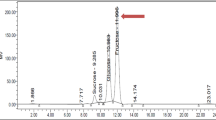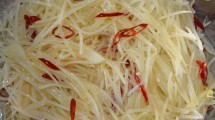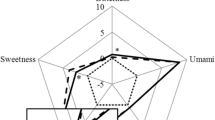Abstract
Sunstruck flavor is an off-flavor formed when beer is exposed to light. Although isohumulone is known as the main substrate, the degradation of substances present in malt also plays a role in its formation. Riboflavin, phenylalanine, sulfur-containing amino acids and the sulfur-containing peptide glutathione have been described as sunstruck flavor initiators, promoting the formation of sunstruck flavor (Charpentier and Maujean in Flavour ´81, 3rd Weurman symposium, Munich, 1981; Huvaere et al. in J Agric Food Chem 53(5):1489–1494, 2005; Kuroiwa and Hashimoto in Am Soc Brew Chem 19:28–36, 1961). Moreover, tryptophan and polyphenols are known to reduce the formation of sunstruck character in beer (inhibitors) (Pozdrik et al. in J Agric Food Chem 54(17):6123–6129, 2006). The initiators and inhibitors of sunstruck flavor originate in the raw material used, and their content can be influenced during manufacturing. The aim of this paper was to define the influence of the malting process parameters on the content of initiators and inhibitors involved in the formation of sunstruck flavor in different cereals. Barley, spelt and triticale were malted under different parameters, and the content of the sunstruck flavor initiators and inhibitors was analyzed. The initiator and inhibitor contents were described by linear, two-factor interaction or quadratic models. The malting parameters exert in most of the substances a positive influence. The germination temperature had a negative influence on the content of cysteine, methionine and tryptophan of triticale. The germination time and temperature showed a negative influence on the tryptophan content of spelt. With the knowledge gained, the potential of different cereals for its use in the development of malted cereal-based beverages can be determined. Moreover, the influence of malting process on the content of these substances as well as differences between the raw materials was defined.







Similar content being viewed by others
References
Charpentier N, Maujean A (1981) Sunlight flavours in champagne wines. In: Schreier P (ed) Flavour ´81, 3rd Weurman symposium, Munich
Huvaere K, Andersen ML, Skibsted LH, Heyerick A, De Keukeleire D (2005) Photooxidative degradation of beer bittering principles: a key step on the route to lightstruck flavor formation in beer. J Agric Food Chem 53(5):1489–1494
Kuroiwa Y, Hashimoto N (1961) Composition of Sunstruck flavor substance and mechanism of its evolution. Am Soc Brew Chem 19:28–36
Pozdrik R, Roddick FA, Rogers PJ, Nguyen T (2006) Spectrophotometric method for exploring 3-methyl-2-butene-1-thiol (MBT) formation in lager. J Agric Food Chem 54(17):6123–6129
Lintner C (1875) Die Bierbrauerei. Friedrich vieweg und sohn verlag, Braunschweig
Kuroiwa Y, Hashimoto N, Kokubo E, Nakagawa K (1963) Factors essential for the evolution of sunstruck flavor. J Am Soc Brew Chem 21:181–193
Gunst F, Verzele M (1978) On the sunstruck flavor of beer. J Inst Brew 84:291–292
Komarek D, Hartmann K, Schieberle P, (2002) Changes in key odorants in beer during exposure to light. In: The 10th Weurman flavour research symposium, Beaune2002
Becker T, Schieberle P (2011) Optimierung von Rezeptur und Herstellungsverfahren zur Vermeidung qualitätsmindernder Aromastoffe in hopfenhaltigen Getränken. Abschlussbericht. Forschungskreis der Ernährungsindustrie e.V, Bonn
Huvaere K, Sinnaeve B, Van Bocxlaer J, De Keukeleire D (2004) Photooxidative degradation of beer bittering principles: product analysis with respect to lightstruck flavour formation. Photochem Photobiol Sci 3:854–858
Maye JP, Mulqueen S, Weis S, Xu J, Preist M (1999) Preparation of isomerized a-acid standards for HPLC analysis of iso-a-acids, roh-iso-a-acids, tetrahydro-iso-a-acids and hexahydro-iso-a-acids. Am Soc Brew Chem J 57(2):55–59
De Keukeleire D, Heyerick A, Huvaere K, Skibsted LH, Andersen ML (2008) Beer lightstruck flavor: the full story. Cerevisia (Bilingual Edition) 33(3):133–144
Sakuma S, Rikimaru Y, Kobayashi K, Kokawa M (1991) Sunstruck flavor formation in beer. J Am Soc Brew Chem 49:162–165
Huvaere K, Andersen ML, Storme M, Van Bocxlaer J, Skibsted LH, De Keukeleire D (2006) Flavin-induced photodecomposition of sulfur-containing amino acids is decisive in the formation of beer lightstruck flavor. Photochem Photobiol Sci 5(10):961–969
Irwin AJ, Bordeleau L, Barker RL (1993) Model studies and flavor threshold determination of 3-methyl-2-butene-1-thiol in beer. J Am Soc Brew Chem 51:1–3
Templar J, Arrigan K, Simpson WJ (1995) Formation, measurement and significance of lightstruck flavor in beer a review. Brew Digest 70:18–25
Patton S (1954) The mechanism of sunlight flavor formation in milk with special reference to methionine and riboflavin. J Dairy Sci 37:446–452
Goldsmith MR, Rogers PJ, Cabral NM, Ghiggino KP, Roddick FA (2005) Riboflavin triplet quenchers inhibit lightstruck flavor formation in beer. J Am Soc Brew Chem 63(4):177–184
Komarek D, Hartmann K, Schieberle P (2004) The role of 3-methyl-2-butene-1-thiol in beer flavor. In: Deibler DK, Delwiche J (eds) Handbook of flavor characterization. Sensory analysis, chemistry, and physiology, vol 1, 2, 3, 2nd edn. Marcel Dekker Inc, New York, Basel, pp 473–481
Blockmans C, Meersche J, Masschelein CA, Devreux A (1981) Photodegradation and formation of carbonyl-and sulphur compounds in beer. In: European Brewery Convention, Proceedings of 18th Congress, Copenhagen, pp 347–357
Becker EM, Cardoso DR, Skibsted LH (2005) Deactivation of riboflavin triplet-excited state by phenolic antioxidants: mechanism behind protective effects in photooxidation of milk-based beverages. Eur Food Res Technol 221(3):382–386
Cardoso DR, Olsen K, Møller JK, Skibsted LH (2006) Phenol and terpene quenching of singlet-and triplet-excited states of riboflavin in relation to light-struck flavor formation in beer. J Agric Food Chem 54(15):5630–5636
Haggi E, Bertolotti S, Garcı́a NA (2004) Modelling the environmental degradation of water contaminants. Kinetics and mechanism of the riboflavin-sensitised-photooxidation of phenolic compounds. Chemosphere 55(11):1501–1507
Kaukovirta-Norja A, Wilhelmson A, Poutanen K (2004) Germination: a means to improve the functionality of oat. Agric Food Sci 13:100–112
Klose C (2010) Oats proteins and their changes during malting and brewing in comparison to barley proteins. University College Cork, Cork
Briggs DE (1998) Malts and malting. Blackle Academic and Professional, London
Klose C, Schehl BD, Arendt EK (2009) Fundamental study on protein changes taking place during malting of oats. J Cereal Sci 49(1):83–91
Narziß L, Back W (2012) Die Bierbrauerei: band 1: Die Technologie Der Malzbereitung. VCH
Goupy P, Hugues M, Boivin P, Amiot MJ (1999) Antioxidant composition and activity of barley (Hordeum vulgare) and malt extracts and of isolated phenolic compounds. J Sci Food Agric 79(12):1625–1634
Bellmer H (1976) Studie über die Polyphenole und deren Polymerisationsindex in den Rohstoffen des Bieres und ihre Veränderungen während der Bierbereitung. Technische Universität München, Munich
Gastl M, Mezger R, Back W (2007) The meaning of water soluble vitamins B1 and B2 in the brewing process measured by HPLC. In: Paper presented at the European Brewery Convention: Proceedings of the 31th Congress, Venice
Aerts G, De Cooman L, De Rouck G, Goiris K (2007) Use of hop polyphenols in beer. Google Patents
Norris LM, Mccord JD, Henis J, Hoehn MJ (2002) Method of altering and improving taste characteristics of edible consumables with monomeric or oligomeric polyphenolic compounds. US Patent 20,020,001,651
Gawel R (1998) Red wine astringency: a review. Aust J Grape Wine Res 4(2):74–95
Heyerick A (2001) Unraveling the mechanism of the lightstruck flavor of beer. Ghent University, Ghent
Anger H-M (2006) Brautechnische Analysenmethoden-Rohstoffe. Selbstverlag der Mitteleuropäische Brautechnische Analysenkommission, Freising
Khuri AI, Cornell JA (1996) Response surfaces: designs and analyses, vol 152. CRC Press, Boca Raton
Joglekar A, May A (1987) Product excellence through design of experiments. In: Cereal foods world, vol 32, 12, pp 857
Krömer JO (2006) Systembiotechnologische Studien an Corynebacterium glutamicum zur Charakerisierung der Methioninsynthese. Universitätsbibliothek
Alvarez-Jubete L, Wijngaard H, Arendt E, Gallagher E (2010) Polyphenol composition and in vitro antioxidant activity of amaranth, quinoa buckwheat and wheat as affected by sprouting and baking. Food Chem 119(2):770–778
Singleton V, Rossi JA (1965) Colorimetry of total phenolics with phosphomolybdic-phosphotungstic acid reagents. Am J Enol Vitic 16(3):144–158
Zielinski H, Kozlowska H, Lewczuk B (2001) Bioactive compounds in the cereal grains before and after hydrothermal processing. Innov Food Sci Emerg Technol 2(3):159–169
Piendl A (2000) Physiologische Bedeutung der Eigenschaften des Bieres. Carl
Krahl M, Hagel C, Zarnkow M, Back W, Kreisz S (2008) Changes of the content of water-soluble bioactive compounds during the malting process of spelt wheat (Triticum aestivum var. spelta). Brew Sci 10:169–173
Hassani A, Zarnkow M, Becker T (2013) Influence of malting conditions on sorghum (Sorghum bicolor (L.) Moench) as a raw material for fermented beverages. Food Sci Technol. doi:10.1177/1082013213490710
Grela ER (1996) nutrient composition and content of antinutritional factors in spelt (Triticum spelta L.) Cultivars. J Sci Food Agric 71(3):399–404
Belderok B (1968) Changes in thiol and disulphide contents in barley embryos during dormancy and after-ripening. J Inst Brew 74(4):333–340
Pheifer JH, Briggs DE (1995) Thiols and disulphides in quiescent and germinating barley grains, both dormant and mature. J Inst Brew 101(2):85–93
Kunze W (2007) Technologie Brauer and Mälzer. VLB Berlin, Berlin (In German)
Narziß L (1999) Die Technologie der Malzbereitung. Ferdinand Enke Verlag, Stuttgart, Germany, Die Bierbrauerei (In German)
Salama ARA, El-Sahn MA, Mesallam AS, Shehata AM (1997) The chemical composition, the nutritive value and the functional properties of malt sprout and its components (acrospires, rootlets and husks). J Sci Food Agric 75(1):50–56
Saura-Calixto F, Serrano J, Pérez-Jiménez J (2011) What Contribution Is Beer to the Intake of Antioxidants in the Diet? Beer in Health and Disease Prevention:441
Isoe A, Kangawa K, Ono M, Nakantani K, Nishigaki M (1991) Evaluation of dehusked malt and its influence on the brewing process and beer quality. In: Proceedings of the European Brewing Convention Congress, Lisbon, Oxford, pp 37–42
Glatthar J, Heinisch JJ, Senn T (2003) The use of unmalted triticale in brewing and its effect on wort and beer quality. J Am Soc Brew Chem 61(4):182–190
Author information
Authors and Affiliations
Corresponding author
Ethics declarations
Conflict of interest
The authors declare that they have no conflict of interest.
Compliance with ethics requirements
This article does not contain any studies with human or animal subjects.
Rights and permissions
About this article
Cite this article
Munoz-Insa, A., Gastl, M. & Becker, T. Variation of sunstruck flavor-related substances in malted barley, triticale and spelt. Eur Food Res Technol 242, 11–23 (2016). https://doi.org/10.1007/s00217-015-2513-z
Received:
Revised:
Accepted:
Published:
Issue Date:
DOI: https://doi.org/10.1007/s00217-015-2513-z




